The recent equinox marked a significant change from a very hot and rain-free couple of weeks to relatively cool conditions, and rain is forecast every day for the next ten days at least. This sudden change had me reflecting on the seasons and how they are represented in our neck of the woods.
Of course that the equinox marked such a change was entirely coincidental. This summer, the eastern side of South Africa (where I live in the province of KwaZulu-Natal) has had more than usual rains, although many regions in the country remain stuck in horrendous long-term drought conditions. Our fairly localised higher-than-normal summer rainfall is said to be because the El Niño-Southern Oscillation (ENSO) cycle is currently in the cooler La Niña phase, a phase that is forecast to diminish as the year progresses.
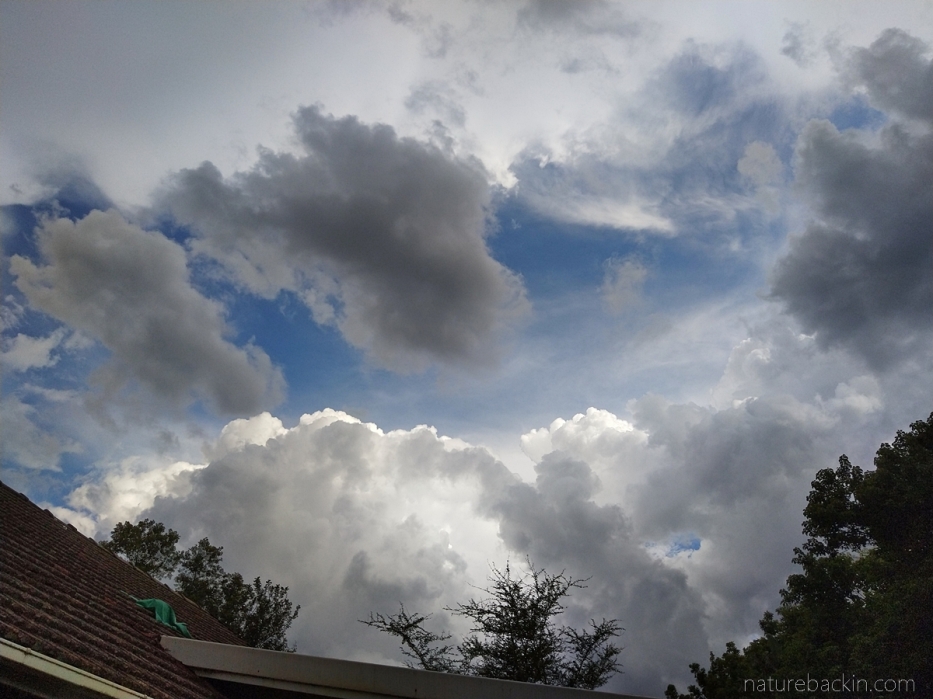
A summer storm rumbling in – picture taken in January this year. The small green tarp visible on the roof of our house covers a damaged skylight that was smashed in a severe hailstorm late last year. (Only this month repairs to the hail damage to the house were finally completed.)
In South Africa there is no officially designated schedule of the seasons and we tend to follow the three-months-per-season convention that is often based on the divisions of the solstices and the equinoxes. However, these divisions may not accurately correlate to weather patterns. Identifying the seasons is significant for many human activities and for resource management from agriculture to tourism.

A topographic map of southern Africa. The small landlocked mountainous country towards the eastern side that is outlined in red is Lesotho. I live in Pietermaritzburg, which is on the edge of the escarpment that rises up between the coast and the mountains that border the eastern side of Lesotho. (Map: Wikimedia Commons. Topographic map of South Africa. Created with GMT from public domain GLOBE data. 21 June 2007. Author: Sadalmelik.)
South Africa is considered to be a largely semi-arid country and it is situated in the subtropics (with a northern top corner peeking into the Tropic of Capricorn). The country is subject to a variety of weather systems and its regional weather patterns are also influenced by a variety of factors such as proximity to the long coastline as well as considerable variations in altitude including the presence of a large inland plateau.

September raindrops in our garden after the long dry months of winter
In South Africa some regions have the bulk of their rainfall in the colder months and others in the hotter months, but with significant inconsistencies across regions. In the arid and semi-arid regions the scarcity of the rainfall means that it cannot be used as an indicator of the seasons. In addition to distinct differences in rainfall across the country, the temperatures too can vary tremendously.
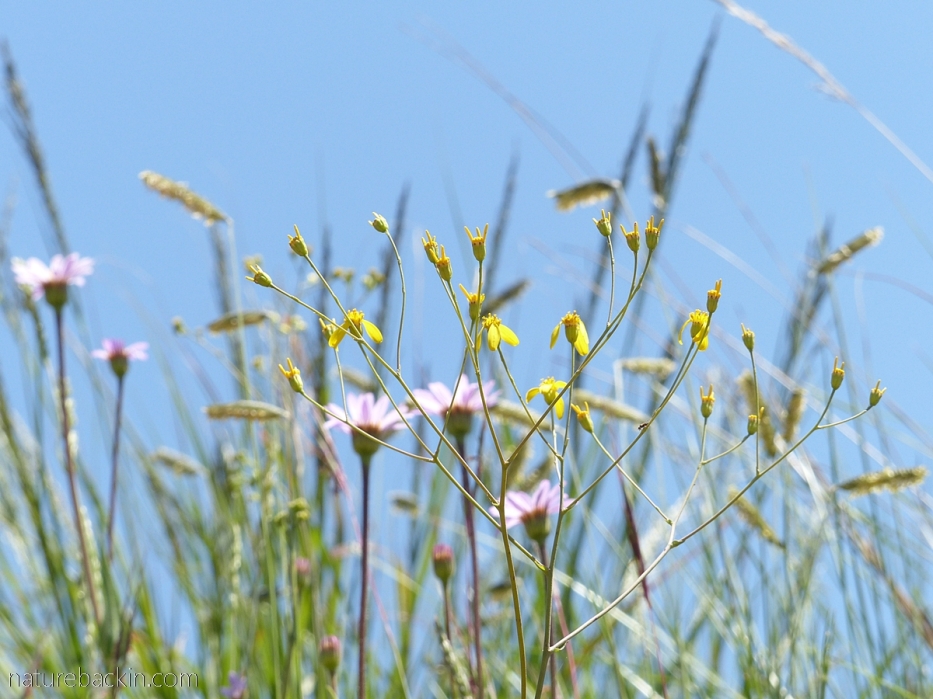
Early summer (November) flowers in a patch of the increasingly rare and threatened natural grassland areas in the KwaZulu-Natal Midlands
In a recent study (Van der Walt & Fitchett, 2020), daily temperature readings taken from records from 35 weather stations over a period of 35 years (1980 to 2015) were collated and the data was used as a statistical basis for classifying the seasons. Of course there were variations across regions and altitudes but on average summer was found to be the longest season (October to March) with winter occurring June to August. The greatest variability was in the onset and ending of spring and of autumn, but typically spring is in September and early autumn in April and late autumn in May.
The most significant regional differences are that summers start later and winters end later in the south western regions, and in the northeast summers start earlier and winters end earlier.

Spangled with raindrops an indigenous gerbera (Gerbera ambigua) when in full bloom in our garden in spring. These lovely daisies continue flowering well into summer
At the weather stations closest to Pietermaritzburg that were used in the study, it was recorded that spring-like temperatures may commence as early as August and late spring temperatures may continue through to November – so there is a rather gradual merging of spring into summer in this region.
A major significance of temperature is that air temperatures are directly related to ‘phenological shifts’ – i.e. temperature has a direct influence on periodic biological phenomena such as breeding, flowering and migration.

Butterflies are most prolific in our garden in the months of late summer and early autumn. I photographed this Natal acraea (Acraea natalica natalica) in our garden on a hot afternoon last week
I expect that almost everybody across the world is experiencing at least some of the effects of climate change, be they in the form of extreme weather events or noticeable increases in average temperatures. Shifts in climate trends that have already been observed in South Africa (1960–2010) include annual increases in maximum and minimum temperatures across the seasons and in most zones. Mean annual temperatures have increased by more than 1.5 times the observed global average of 0.65°C (SANBI factsheet).
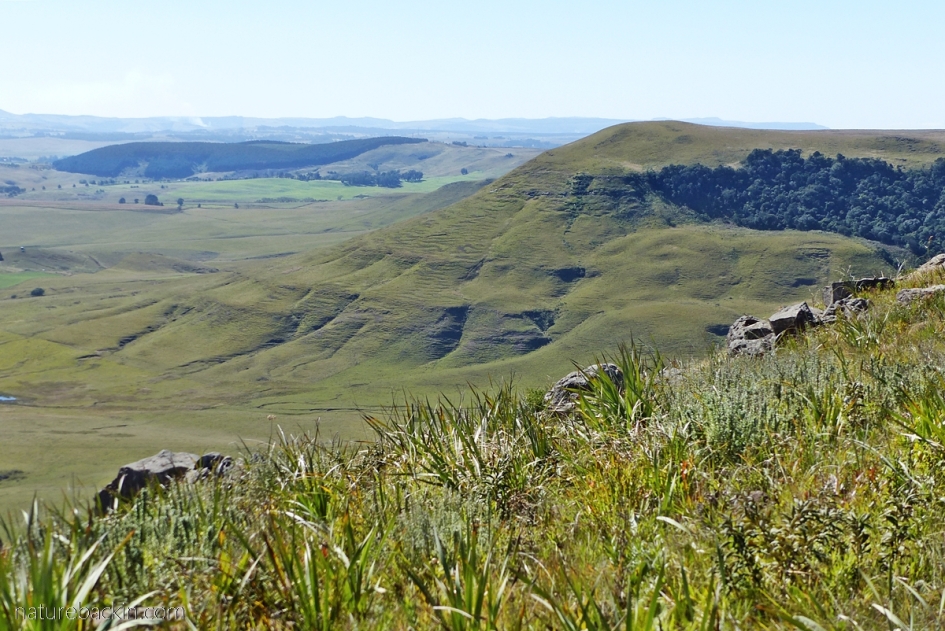
A view photographed from a high ridge in the Fort Nottingham area of the Kwa-Zulu Natal (KZN). A patch of indigenous forest can be seen to the right of the photo in the lee of the high ridge, and the dark green patch of trees in the distance is a commercial plantation of exotic trees – probably eucalyptus
Some of the forecast climate change trends for southern Africa relate to increasing average temperatures especially inland (with predicted increases being as high as 5–8°C by 2050), with a corresponding decrease in rainfall especially across the western regions and the interior, whereas the eastern areas is likely to be wetter, including high intensity rainfall events.

Beef cattle being moved to paddock early on a misty morning in the summer on a farm in the KZN Midlands
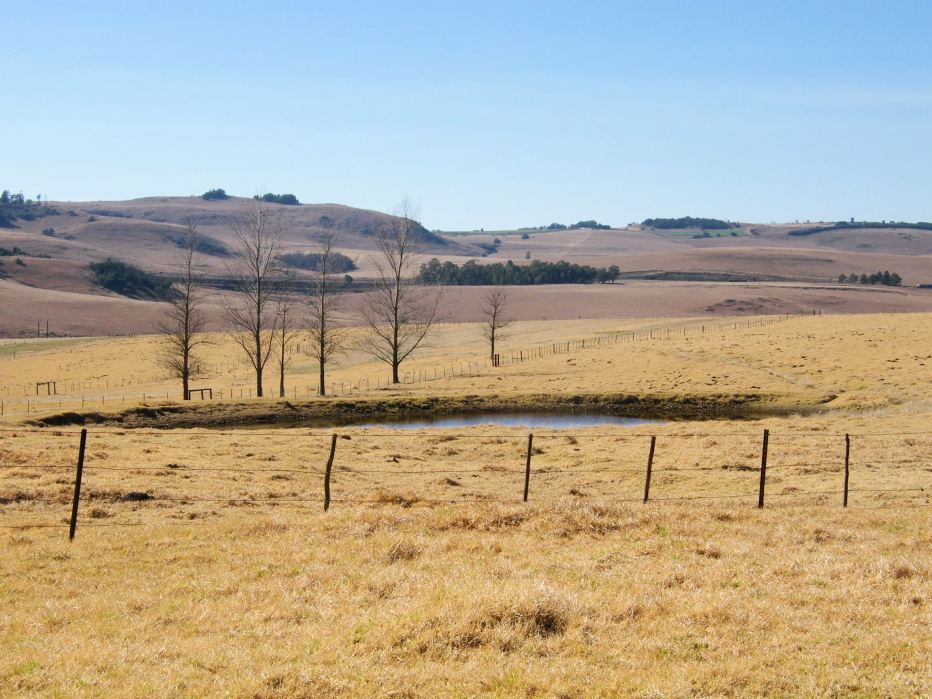
By contrast, here is a view of KZN Midlands farmland in the dry winter months. This photo was taken in the month of June near Mooi River

The last flowers of the wild dagga (Leonotus leonurus) in early winter, seen together with grasses that have gone to seed as they grow on a strip of grassland between an indigenous forest patch and grassland used for grazing cattle. Some of the trees in the background are naturalised Black wattle (Acacia mearnsii) trees. Black wattle trees were first introduced to South Africa from Australia to be grown commercially to provide a bark extract that can be used for tanning hides. The wood is used for lumber, it is chipped for paper manufacture, and it makes good firewood but the naturalized trees have become highly invasive
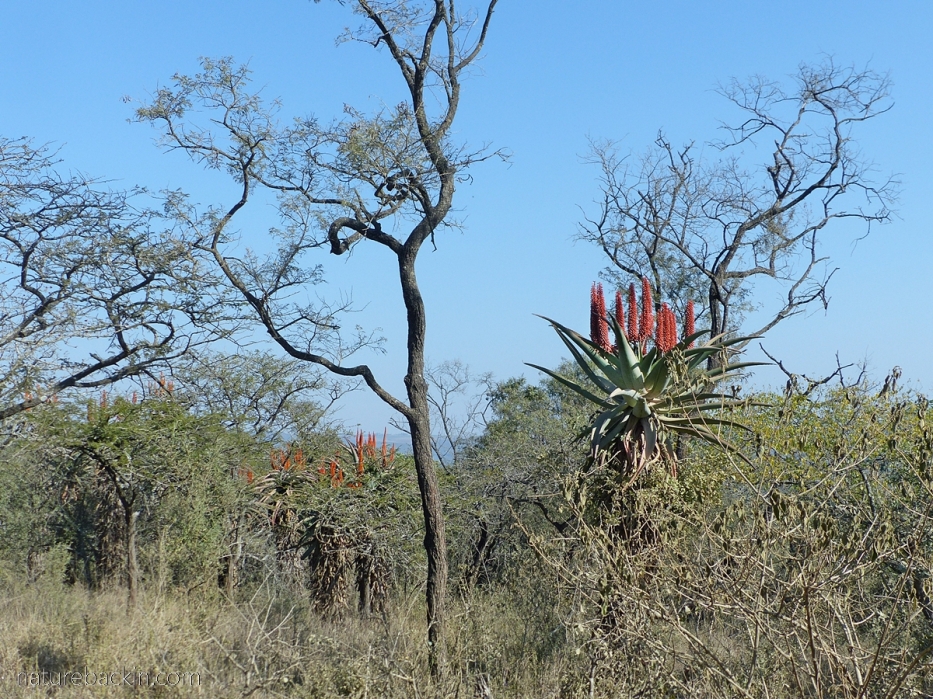
On the other side of town and at a lower elevation, this is a view of the natural bushveld in the Lower Mpushini Valley where the flowers of Aloe Ferox (also known as Aloe candelabrum) are a prominent feature in winter

Aloes are far from being the only winter flowering indigenous plants. Although in some respects red-hot poker (Kniphofia) flowers may remind one of aloes, unlike aloes Kniphofias are not succulents. Some species of Kniphofias flower in the summer and others are winter flowering, such as the Kniphofia praecox pictured above flowering in our garden in June
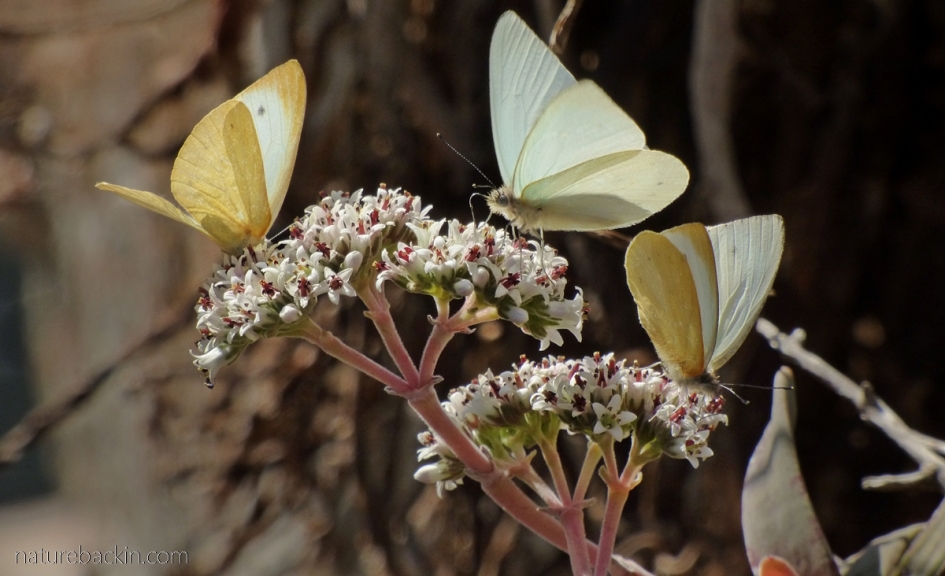
Butterflies feeding on winter flowers of a Crassula species in winter in June at Cumberland Nature Reserve, which is not far from the eastern side of Pietermaritzburg

Small and cheerful gazanias (probably Gazania krebsiana) in flower in a burnt area of grassland at Kamberg Nature Reserve in the Drakensberg region in KZN
Shifting focus from flowers to leaves, although many indigenous trees are deciduous we do not have the spectacularly colourful falls of leaves in autumn as in so many northern hemisphere regions. Many of our deciduous trees drop their leaves suddenly in winter, and in wetter areas with milder winters they may tend more to being semi-deciduous even retaining some of the old leaves as the new leaves are appearing in the spring.
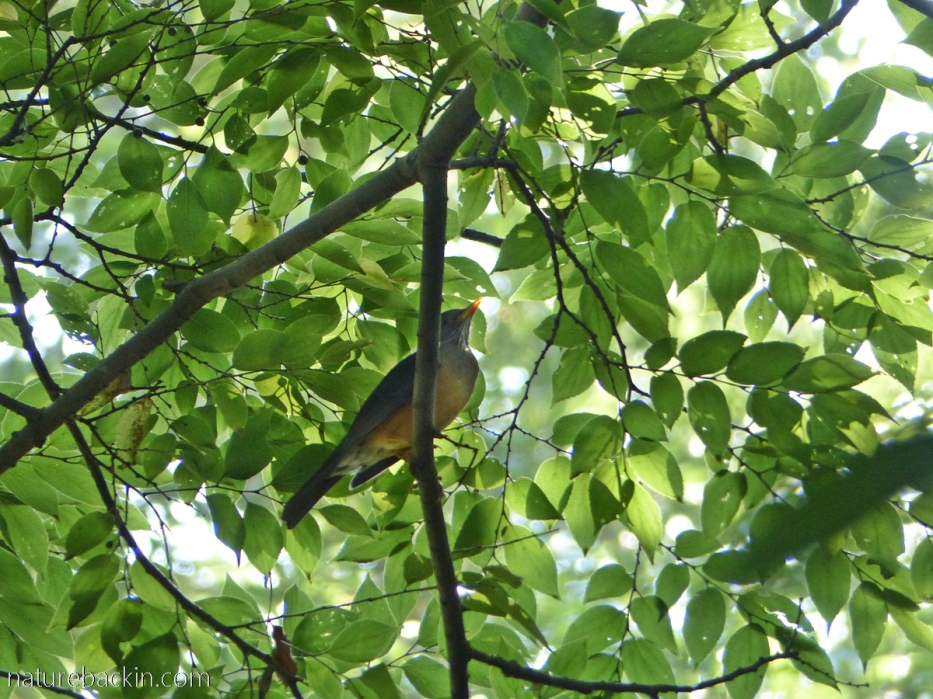
For example this white stinkwood (Celtis africana), on the margins of our garden, retains its leaves in April in early autumn. The bird is an olive thrush (Turdus olivaceus)

In our area where the winters are mild, by July the leaves of the white stinkwood are changing colour with some leaves already having fallen
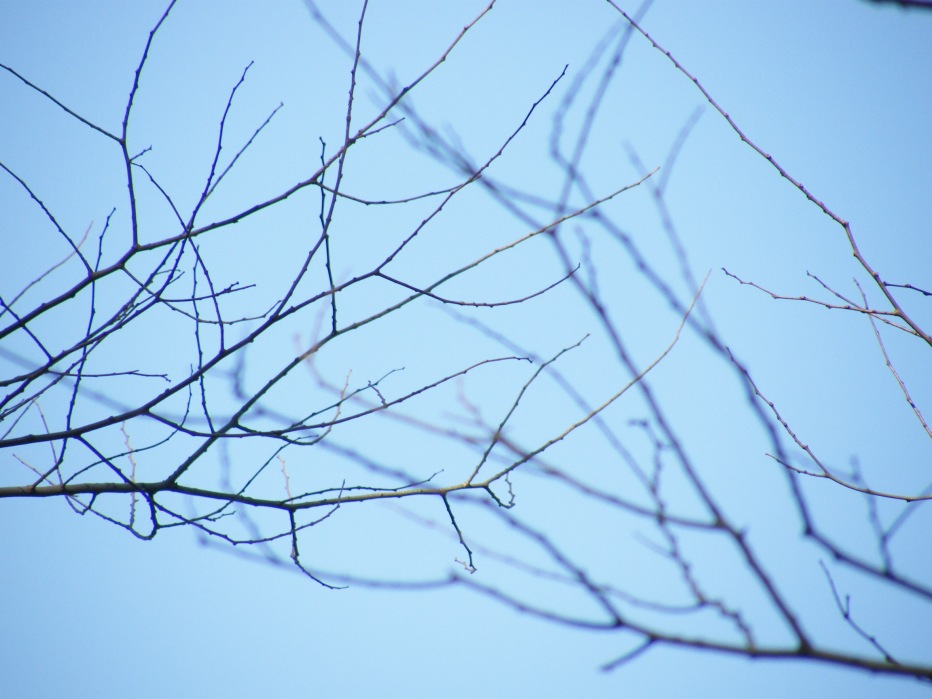
By July the white stinkwoods in our neighbourhood are completely bare of leaves

The fallen leaves carpet the ground in a lovely layer of mulch. Thrushes and other birds have a fruitful time tossing aside the leaves searching for food
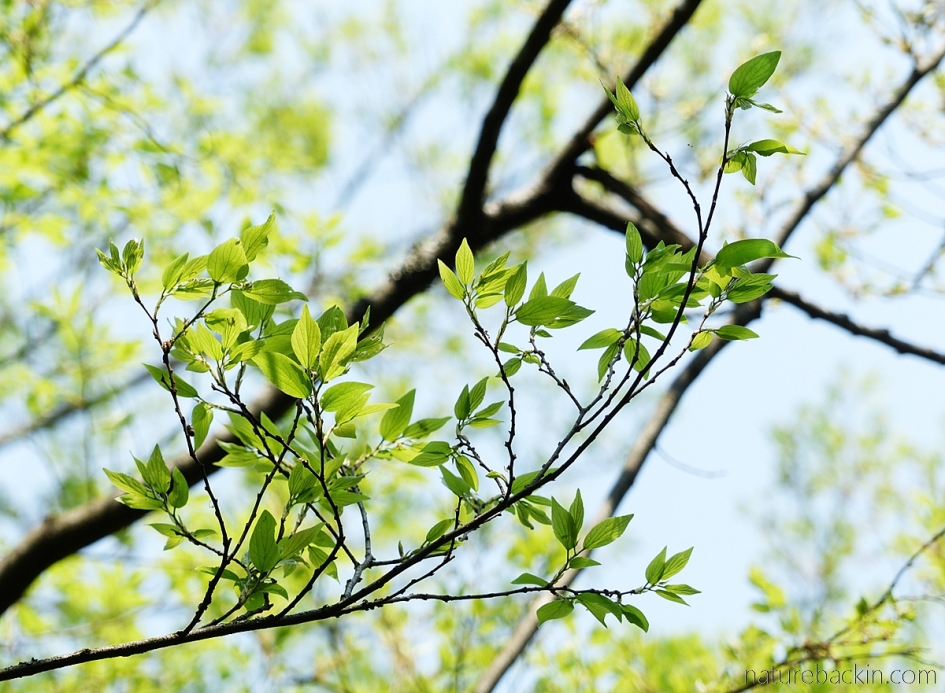
During September the white stinkwood trees become flush with beautiful new leaves. The tree’s small flowers and tiny fruits appear during the summer

We do have one indigenous tree in the garden that has spectacularly colourful leaves although not all the leaves change colour at the same time so the effect is not as dramatic as it might be. This is the forest bushwillow (Combretum krausii), which in milder areas may only be semi-deciduous
And to end off this post, I have rather randomly selected a photo from each season.
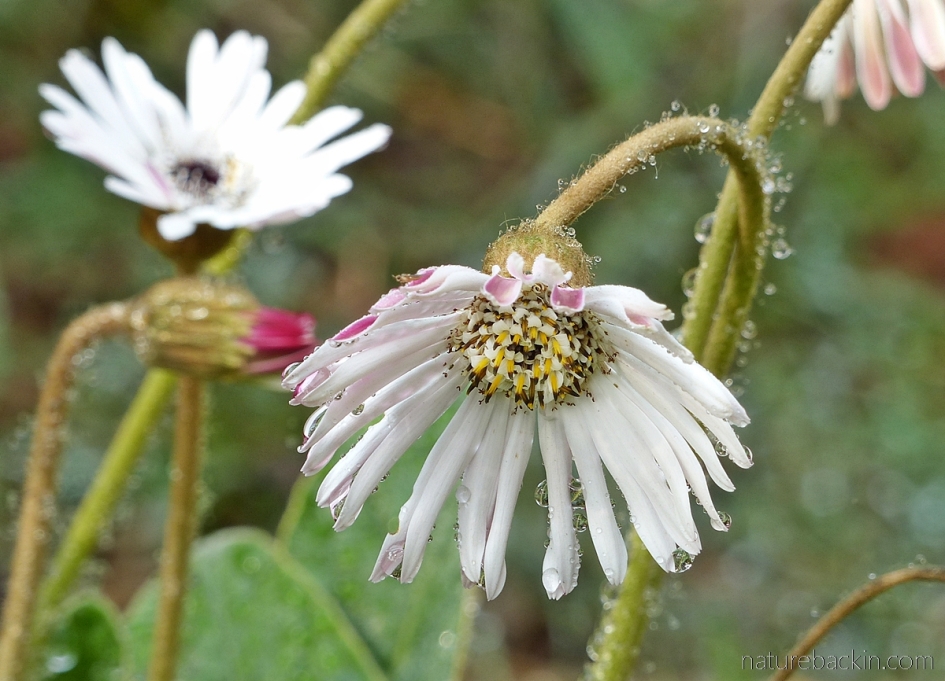
Another photo of Gerbera ambigua flowers in the mini grassland in our garden in the spring

A clearing in mistbelt forest in the KZN midlands where the forest spurflower (Plectranthus fruticosus) was flowering in the late summer

A common waxbill looking for seeds in the golden bristle grass (Setaria sphacelata sericea) in our garden during the early autumn month of April

An increasingly rare sight in our garden is winter frost. Although we still may get frost on a few winter nights in the more exposed parts of the garden, we never do get as much frost as in the nearby valley below us. The last widespread frost we experienced was in the winter of 2014 when even water in the birdbath froze. The delicate powdering of frost pictured above occurred in the same year

And to end, here is another photo of the glorious sunrise photographed in January 2018 in the KZN Midlands. This photograph was taken seven minutes earlier than the header photograph at the top of this post
Sources
SANBI. [n.d.] Climate trends and scenarios. Climate and Impacts Factsheet Series, Factsheet 2 of 7. https://www.google.com/search?hl=en&q=climate%20change%20south%20africa%20forecasts
Van der Walt, Adriaan J. & Jennifer M. Fitchett. 2020. Statistical classification of South African seasonal divisions on the basis of daily temperature data. South African Journal of Science. 116(9/10). 15 pages. https://doi.org/10.17159/sajs.2020/7614
Posted by Carol









April 2, 2021 at 10:23 am
I thoroughly enjoyed reading your post! In fact, I have read it a couple of times during the week, as it stirs dormant memories of the Midlands and PMB itself, where I resided for many years. We have also experienced the El Nina this year, hence the overabundance of rainfall that we have been blessed with!
Your photos are just amazing! I love the rain drops on the stem, plus those on the Gerbera! Then the photos taken in the Midlands brought back many happy memories of the various seasons and the wonderful colours of the vistas. The Aloe ferrox photo is lovely too! The Celtis was a tree remembered from childhood, which stood in the centre of the lawn in the front garden! Your selection of seasonal photos is just lovely too! Thank you Carol!
LikeLiked by 1 person
April 5, 2021 at 2:32 pm
It is lovely to know that this post has stirred happy memories for you of Pmb and the Midlands. Rain is a blessing, but obviously not an overabundance leading to tragic floods …
The Celtis in your childhood garden must have been a real indicator of the seasonal changes.
And now our winter flowers are forming buds and the first wild dagga flowers are starting to open. Autumn is lovely but winter is definitely on its way!
LikeLiked by 1 person
March 29, 2021 at 10:04 am
Thank you for writing about the the studies that confirm that the seasons are indeed shifting and, as always, for the beautiful photographs. I too measure the change in season through the white stinkwood in our garden. At the moment there are swathes of plectranthus in blue, pink and white in the garden and the ribbon bush that I slipped a year ago (after reading one of your posts) is growing vigorously. The short autumn is perhaps my favourite garden season.
LikeLiked by 1 person
April 1, 2021 at 9:09 pm
I have just seen that my reply somehow disappeared!
How nice that we both use the white stinkwoods as guides to the changing seasons,
I hope that your ribbon bush flowers in about May – when it flowers here. It is rather worrying that we have had no honey bees about for some time. Usually they visit the ribbon bushes when they are in flower so we are hoping to see them again then in May, if not before.
LikeLike
April 2, 2021 at 6:25 am
Hope fervently that the bees return
LikeLiked by 1 person
April 2, 2021 at 2:10 pm
Me too. A good sign today – I saw one honey bee visiting flowers of the small yellow water lily at the garden pond.
LikeLiked by 1 person
March 28, 2021 at 5:41 am
A fabulous sunrise, well worth getting up for. Another very informative post Carol, with the usual great photos. The seasons you experience, and the changes to them, are most interesting. A few weeks ago, we had a spell of around 14 days where the northeast trade winds blew strongly and consistently. We remarked how nice that was because it had been so long since that happened. There’s no doubt the weather has changed here. I’d like to think that we shall return to normal in that regard, but I’m not exactly optimistic about that.
LikeLiked by 1 person
March 28, 2021 at 6:39 pm
We were actually waiting in carpark to meet up with a fellow traveler so it wasn’t the most idyllic setting for such a beautiful sunrise!
It can be quite hard to know what ‘normal’ is anymore. Sadly what humanity has done in the face of the climate crisis so far does not inspire any degree of confidence going forward.
LikeLiked by 1 person
March 29, 2021 at 12:36 am
You’re right about that.
LikeLiked by 1 person
March 28, 2021 at 2:23 am
Dear Carol a beautiful over view of the seasons, with as always very lovely photographs! xxx
LikeLiked by 1 person
March 28, 2021 at 6:35 pm
Thanks very much Christeen xxx
LikeLiked by 1 person
March 26, 2021 at 12:19 pm
I know that it wasn’t the chief intent behind your post, Carol – and what a wonderful post if is, again – but I suddenly find myself longing for another visit to the Midlands!
LikeLiked by 1 person
March 26, 2021 at 8:43 pm
Thanks, and the Midlands region is blessed with many special places and features.
LikeLiked by 1 person
March 27, 2021 at 3:34 am
Absolutely!
LikeLiked by 1 person
March 26, 2021 at 4:14 am
A marvellous read and an excellent overview of the subtleties of our seasonal changes. We have not enjoyed the abundant rain you mention – our best rain is dependent on cut-off low pressure systems – but stand a chance of light rain falling … sometime. Nonetheless, our white stinkwoods are copying yours, the Cape chestnut leaves are yellowing, the hadedas wake up later in the mornings … so the seasonal changes are becoming more evident.
LikeLiked by 1 person
March 26, 2021 at 8:42 pm
I don’t understand why the effect of the La Nina phase is related to increased rainfall in such limited parts of the country when previous long-term forecasts seemed to have been a bit more optimistic.
Yes the seasonal changes are becoming more evident – especially the shortening of the days.
LikeLiked by 1 person
March 25, 2021 at 11:31 pm
I loved learning all the details and subtleties of your different seasons. CC is definitely adding uncertainty to the variations and that is worrisome particularly for food production and water resources. It is complex and the answers seem out of our control, but the longer we dither, the worse it gets. I try to conserve where I can and enjoy and appreciate each day as it comes. There is much to be grateful for.
Love your photos, Carol. Beautiful landscapes, plants and flowers!
LikeLiked by 1 person
March 26, 2021 at 8:36 pm
Thanks Eliza. I think that your questions re our latitude and temps probably influenced where I went with this post, so thanks for that.
In a way the multiple anxieties and problems related to Covid serve to take our minds off the profound and long-term dynamics of climate change and may lead to even worse inaction and delay.
Yes there is much to be grateful for even when there is so much at stake.
LikeLiked by 1 person
March 26, 2021 at 8:46 pm
I’m glad to report that the new administration here has taken action to reverse a lot of gutting of protections that happened with the previous one. A lot of lost ground has to be covered, but at least most of the states never backtracked and are now enacting more CC legislation with greater federal backing. Hope!
LikeLiked by 1 person
March 26, 2021 at 8:50 pm
So much ground was lost, but there are now reasons to be less despondent and indeed more hopeful. Thanks Eliza.
LikeLiked by 1 person
March 25, 2021 at 8:58 pm
Oh, I forgot to say. Fabulous sunset images.
LikeLiked by 1 person
March 26, 2021 at 8:30 pm
Thanks Margaret – it was a glorious sky. A pernickety point, but for someone who is not really a morning person it is worth acknowledging that it was a sunrise 🙂
LikeLiked by 1 person
March 27, 2021 at 8:29 am
Whoops! Sorry. All the more special for you if it’s not your best time of day.
LikeLiked by 1 person
March 28, 2021 at 6:34 pm
🙂
LikeLike
March 25, 2021 at 8:58 pm
Your climatic fluctuations and changes sound even more dramatic and damaging than ours here in Europe. And it was interesting to know where you live – your town sounds an interesting one, I had to be nosy and look it up! Though the photos you show, especially the ones of flowers are doubtless not from the town centre!
LikeLiked by 1 person
March 26, 2021 at 8:28 pm
It is an interesting town though going through difficult times. We live on its edge – and indeed I did not show photos from the centre of town.
LikeLiked by 1 person
March 27, 2021 at 8:29 am
No – that’s why I went running to Google!
LikeLiked by 1 person